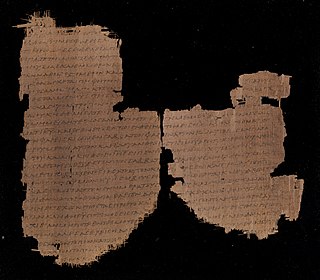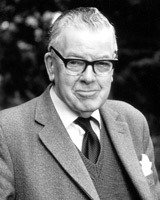Related Research Articles

The Acts of the Apostles is the fifth book of the New Testament; it tells of the founding of the Christian Church and the spread of its message to the Roman Empire.

The Gospel of Luke tells of the origins, birth, ministry, death, resurrection, and ascension of Jesus Christ. Together with the Acts of the Apostles, it makes up a two-volume work which scholars call Luke–Acts, accounting for 27.5% of the New Testament. The combined work divides the history of first-century Christianity into three stages, with the gospel making up the first two of these – the life of Jesus the Messiah from his birth to the beginning of his mission in the meeting with John the Baptist, followed by his ministry with events such as the Sermon on the Plain and its Beatitudes, and his Passion, death, and resurrection.

Matthew the Apostle is named in the New Testament as one of the twelve apostles of Jesus. According to Christian traditions, he was also one of the four Evangelists as author of the Gospel of Matthew, and thus is also known as Matthew the Evangelist.
The New Testament (NT) is the second division of the Christian biblical canon. It discusses the teachings and person of Jesus, as well as events relating to first-century Christianity. The New Testament's background, the first division of the Christian Bible, is called the Old Testament, which is based primarily upon the Hebrew Bible; together they are regarded as sacred scripture by Christians.

The Gospel of Thomas is an extra-canonical sayings gospel. It was discovered near Nag Hammadi, Egypt, in December 1945 among a group of books known as the Nag Hammadi library. Scholars speculate that the works were buried in response to a letter from Bishop Athanasius declaring a strict canon of Christian scripture. Scholars have proposed dates of composition as early as 60 AD and as late as 250 AD. Since its discovery, many scholars have seen it as evidence in support of the existence of a "Q source" which might have been very similar in its form as a collection of sayings of Jesus without any accounts of his deeds or his life and death, referred to as a sayings gospel.

Mark 16 is the final chapter of the Gospel of Mark in the New Testament of the Christian Bible. Christopher Tuckett refers to it as a "sequel to the story of Jesus' death and burial". The chapter begins after the sabbath has ended, with Mary Magdalene, Mary the mother of James, and Salome purchasing spices to bring to the tomb next morning to anoint Jesus' body. There they encounter the stone rolled away, the tomb open, and a young man dressed in white who announces the resurrection of Jesus (16:1–6). The two oldest manuscripts of Mark 16 conclude with verse 8, which ends with the women fleeing from the empty tomb, and saying "nothing to anyone, because they were too frightened".

In Christianity, disciple is a dedicated follower of Jesus. This term is found in the New Testament only in the Gospels and Acts. In the ancient world, a disciple is a follower or adherent of a teacher. Discipleship is not the same as being a student in the modern sense. A disciple in the ancient biblical world actively imitated both the life and teaching of the master. It was a deliberate apprenticeship which made the fully formed disciple a living copy of the master.

Jesus, also referred to as Jesus Christ, Jesus of Nazareth, and many other names and titles, was a first-century Jewish preacher and religious leader. He is the central figure of Christianity, the world's largest religion. Most Christians believe Jesus to be the incarnation of God the Son and the awaited messiah, the Christ that is prophesied in the Hebrew Bible.

Frederick Fyvie Bruce, usually cited as F. F.Bruce, was Rylands Professor of Biblical Criticism and Exegesis at the University of Manchester from 1959 until 1978 and one of the most influential evangelical scholars of the second half of the twentieth century. His importance comes from the fact that in a time when the academic community looked down upon Evangelicals, Bruce demonstrated that worthwhile academic work could be done by a scholar holding evangelical views. At the same time, he persuaded Evangelicals that they should not turn their backs on academic methods of Bible study, even if the results might differ from traditional evangelical views. As a result, he has been called the "Dean of Evangelical Scholarship".

The study of Jesus in comparative mythology is the examination of the narratives of the life of Jesus in the Christian gospels, traditions and theology, as they relate to Christianity and other religions. Although the vast majority of New Testament scholars and historians of the ancient Near East agree that Jesus existed as a historical figure, most secular historians also agree that the gospels contain large quantities of ahistorical legendary details mixed in with historical information about Jesus's life. The Synoptic Gospels of Mark, Matthew, and Luke are heavily shaped by Jewish tradition, with the Gospel of Matthew deliberately portraying Jesus as a "new Moses". Although it is highly unlikely that the authors of the Synoptic Gospels directly based any of their accounts on pagan mythology, it is possible that they may have subtly shaped their accounts of Jesus's healing miracles to resemble familiar Greek stories about miracles associated with Asclepius, the god of healing and medicine. The birth narratives of Matthew and Luke are usually seen by secular historians as legends designed to fulfill Jewish expectations about the Messiah.

Richard Cevantis Carrier is an ancient historian. He is long-time contributor to skeptical websites, including The Secular Web and Freethought Blogs, Carrier has published a number of books and articles on philosophy and religion in classical antiquity, discussing the development of early Christianity from a skeptical viewpoint, and concerning religion and morality in the modern world. He has publicly debated a number of scholars on the historical basis of the Bible and Christianity. He is a prominent advocate of the theory that Jesus did not exist, which he has argued in a number of his works. Carrier's methodology and conclusions in this field have proven controversial and unconvincing to most ancient historians, and he and his theories are often identified as fringe.

The Jewish–Christian Gospels were gospels of a Jewish Christian character quoted by Clement of Alexandria, Origen, Eusebius, Epiphanius, Jerome and probably Didymus the Blind. All five call the gospel they know the "Gospel of the Hebrews", but most modern scholars have concluded that the five early church historians are not quoting the same work. As none of the works survive to this day attempts have been made to reconstruct them from the references in the Church Fathers. The majority of scholars believe that there existed one gospel in Aramaic/Hebrew and at least two in Greek, although a minority argue that there were only two, in Aramaic/Hebrew and in Greek.

The Ethiopian eunuch is a figure in the New Testament of the Bible; the story of his conversion to Christianity is recounted in Acts 8.

Christianity in the 1st century covers the formative history of Christianity from the start of the ministry of Jesus to the death of the last of the Twelve Apostles and is thus also known as the Apostolic Age. Early Christianity developed out of the eschatological ministry of Jesus. Subsequent to Jesus' death, his earliest followers formed an apocalyptic messianic Jewish sect during the late Second Temple period of the 1st century. Initially believing that Jesus' resurrection was the start of the end time, their beliefs soon changed in the expected Second Coming of Jesus and the start of God's Kingdom at a later point in time.
The gospel of Luke and the Acts of the Apostles make up a two-volume work which scholars call Luke–Acts. The author is not named in either volume. According to a Church tradition, first attested by Irenaeus, he was the Luke named as a companion of Paul in three of the Pauline letters, but "a critical consensus emphasizes the countless contradictions between the account in Acts and the authentic Pauline letters." The eclipse of the traditional attribution to Luke the companion of Paul has meant that an early date for the gospel is now rarely put forward. Most scholars date the composition of the combined work to around 80–90 AD, although some others suggest 90–110, and there is textual evidence that Luke–Acts was still being substantially revised well into the 2nd century.
The historical reliability of the Gospels is evaluated by experts who have not found a complete consensus. While all four canonical gospels contain some sayings and events which may meet one or more of the five criteria for historical reliability used in biblical studies, the assessment and evaluation of these elements is a matter of ongoing debate. Virtually all scholars of antiquity agree that Jesus of Nazareth existed in 1st century Palestine, but scholars differ on the historicity of specific episodes described in the biblical accounts of Jesus, and the only two events subject to "almost universal assent" are that Jesus was baptized by John the Baptist and was crucified by the order of the Roman Prefect Pontius Pilate. There is no scholarly consensus concerning other elements of Jesus's life including the two accounts of the Nativity of Jesus, the miraculous events including the resurrection, and certain details about the crucifixion.
Ernest Cadman Colwell was an American biblical scholar, textual critic and palaeographer.

In Christian theology and ecclesiology, the apostles, particularly the Twelve Apostles, were the primary disciples of Jesus according to the New Testament. During the life and ministry of Jesus in the 1st century AD, the apostles were his closest followers and became the primary teachers of the gospel message of Jesus. There is also an Eastern Christian tradition derived from the Gospel of Luke of there having been as many as seventy apostles during the time of Jesus' ministry.
Mimesis criticism is a method of interpreting texts in relation to their literary or cultural models. Mimesis, or imitation (imitatio), was a widely used rhetorical tool in antiquity up until the 18th century's romantic emphasis on originality. Mimesis criticism looks to identify intertextual relationships between two texts that go beyond simple echoes, allusions, citations, or redactions. The effects of imitation are usually manifested in the later text by means of distinct characterization, motifs, and/or plot structure.
The intertextual production of the Gospel of Mark is the viewpoint that there are identifiable textual relationships such that any allusion or quotation from another text forms an integral part of the Markan text, even when it seems to be out of context.
References
- 1 2 3 4 Interview with Dennis R MacDonald Archived February 4, 2009, at the Wayback Machine About Atheism. About.com. Retrieved January 13, 2009
- ↑ Christianizing Homer Retrieved January 12, 2009
- ↑ MacDonald, Dennis Ronald. The Homeric epics and the Gospel of Mark. Yale University Press, 2000, 6.
- 1 2 Carrier, Richard. Review of The Homeric Epics and the Gospel of Mark Retrieved January 12, 2009
- ↑ Margaret M. Mitchell, "Homer in the New Testament?" The Journal of Religion 83 (2003): 244-60.
- ↑ Karl Olav Sandnes, "Imitatio Homeri? An Appraisal of Dennis R. MacDonald's "Mimesis Criticism"", Journal of Biblical Literature 1124/4 (2005) 715–732.
- ↑ Gullotta, Daniel N. "On Richard Carrier’s Doubts." Journal for the Study of the Historical Jesus 15.2–3 (2017): 340.
- 1 2 Winn, Adam. Mark and the Elijah-Elisha Narrative: Considering the Practice of Greco-Roman Imitation in the Search for Markan Source Material. Wipf and Stock Publishers, 2010. Pp. 38–49.
- ↑ Litwa, M. David (August 6, 2019). How the Gospels Became History: Jesus and Mediterranean Myths. Yale University Press. pp. 47–50. ISBN 978-0-300-24948-4.
- ↑ Gullotta, Daniel N. "On Richard Carrier’s Doubts." Journal for the Study of the Historical Jesus 15.2–3 (2017): 340.
- ↑ Larsson, Kristian (2014). "Intertextual Density, Quantifying Imitation". Journal of Biblical Literature. 133 (2): 309–331. doi:10.15699/jbibllite.133.2.309. JSTOR 10.15699/jbibllite.133.2.309 – via JSTOR.
- ↑ Litwa, M. David. How the Gospels Became History: Jesus and Mediterranean Myths. Yale University Press, 2019, 47-50.